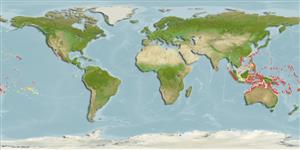>
Blenniiformes (Blennies) >
Blenniidae (Combtooth blennies) > Blenniinae
Etymology: Meiacanthus: Greek, meion = less = lessen + Greek, akantha = thorn (Ref. 45335).
More on author: Günther.
Environment: milieu / climate zone / depth range / distribution range
Οικολογία
Θαλασσινό(ά) Υφαλόφιλο(α); εύρος βάθους 0 - 30 m (Ref. 128797). Tropical; 30°N - 24°S
Western Pacific: Bali and the Philippines east to Samoa, north to Ryukyu Islands, south to Rowley Shoals, the southern Great Barrier Reef, and New Caledonia; throughout Micronesia. Replaced by the uniformly yellow species ovalauensis in Fiji, and by Meiacanthus tongaensis in Tonga (Ref. 37816).
Μέγεθος / Βάρος / Age
Maturity: Lm ? range ? - ? cm
Max length : 11.0 cm TL αρσενικό/απροσδιόριστο; (Ref. 9710)
Ραχιαίες άκανθες (συνολικά): 4; Μαλακές ραχιαίες ακτίνες (συνολικά): 25-28; Εδρικές άκανθες 2; Μαλακές εδρικές ακτίνες: 15 - 18. Identified by the blue-edged diagonal black line from the eye and yellow dorsal fin or back. Adults have long filaments on the caudal fin tips; length without filaments (Ref. 48636).
Adults are found solitary or in pairs (Ref. 90102) in lagoon and seaward reefs below the surge zone to 30 m depth (Ref. 9710). A common species, often seen along slopes and drop-offs, adults sometimes in small groups (Ref. 48636). Feed on zooplankton and also on small benthic invertebrates. Inoffensive, but immune from predation (Ref. 9710). Oviparous. Eggs are demersal and adhesive (Ref. 205), and are attached to the substrate via a filamentous, adhesive pad or pedestal (Ref. 94114). Larvae are planktonic, often found in shallow, coastal waters (Ref. 94114). Mimicked by Ecsenius bicolor and Plagiotremus laudanus (Ref. 90102).
Life cycle and mating behavior
Γεννητική Ωρίμανση | Αναπαραγωγή | Γεννοβολία | Αβγά | Γονιμότητα | Προνύμφες
Oviparous, distinct pairing (Ref. 205).
Myers, R.F., 1991. Micronesian reef fishes. Second Ed. Coral Graphics, Barrigada, Guam. 298 p. (Ref. 1602)
IUCN Red List Status (Ref. 130435)
Warning: mysqli::__construct(): (HY000/1040): Too many connections in /var/www/html/includes/func_getlabel.php on line 46
Can't connect to MySQL database (fbapp). Errorcode: Too many connections
